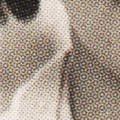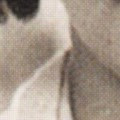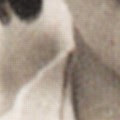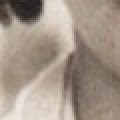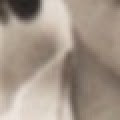kw: book reviews, nonfiction, ancient history, manuscripts, history of science
It may hold the record for the most money paid at auction for the ugliest book (US$2.2 million). It was a wreck. Its sale has caused endless speculation—mainly about who bought it—and endless joy among historians of science, plus endless fascination by quite a variety of scientists who had previously had little truck with "old books."
Word of the day:
palimpsest.
Noun. "A manuscript that has been written on more than once; the earlier writing is often incompletely erased and partially legible." See
FreeDictionary for more details) Origin: Greek
palin (παλιν) "again" +
psēn (πσην) "scrape". Why "again"? Parchment is animal skin, soaked and scraped to remove hair and fat. So to "erase" older writing, a sheet could be soaked and scraped again.
This helps understand the importance of a 13
th Century prayer book comprised of sheets from a number of older works, including 10
th Century manuscript copies of three documents written by Archimedes more than a millennium earlier.

This "ugly book", shown here during its display at Chicago's Field Museum, is a rare find indeed. It is the only surviving codex (bound book, as contrasted with a wound scroll) of Archimedes' work. All images in this post are Copyright the owner of the Archimedes Palimpsest, used by permission.
The Archimedes Palimpsest, AKA Archimedes Codex C, contains most or all (not yet sure) of the text of
Floating Bodies,
Method and
Stomachion, works previously very little known from incomplete quotes. Why "C"? Two other codexes, "A" and "B", existed in "slightly modern" times, but vanished a century or two ago. We don't have them in Greek any more, but in translations...all partial, ranging from good to "interpreted" (
i.e. paraphrased).
Late in 1998, when Codex C was auctioned, a museum curator somewhat hopefully contacted a well-known dealer in manuscripts with the suggestion that the Walters Art Museum might be a suitable venue for public exhibit and scholarly study. "The Walters" in Baltimore, Maryland houses and cares for a large collection of manuscripts. Imagine his surprise to find out the buyer already knew of the Walters and considered it the best such venue!
After a relatively short time (compared to the document's age) the dealer and the owner of the codex visited Will Noel to discuss its curation. This was a formality: the owner had it in a bag he was carrying, and that was that! Dr. Noel and a colleague, historian Reviel Netz of Stanford, became the lead investigators. After nearly ten amazing (and arduous) years of work, they have written
The Archimedes Codex: How a Medieval Prayer Book is Revealing the True Genius of Antiquity's Greatest Scientist. The work has gone amazingly fast, primarily because the owner, is a "rich patron" who makes quick decisions and is very interested in the findings.

What is it like to deal with a palimpsest? Codex C has 174 "leaves", or parchment sheets, folded in the middle and bound together. This produces 348 "pages" with 696 "sides". This photo, taken in deep blue plus near-ultraviolet, shows the state of the art for a hundred years or so, since it became feasible to produce UV light. The sheet is oriented so the Archimedes text is readable, if you read Byzantine Greek. Two diagrams are also visible. The text was written in two columns.
The way UV makes both texts visible is by fluorescence. If you have a "black light" tube, shine it on your skin in a darkened room. That dim bluish look is flourescence (your teeth are much brighter-look in a mirror, but not for too long: UV is bad for your eyes). Ink is not fluorescent, whether it is iron-based or carbon-based. So the bluish light from the parchment is blocked by the older ink almost as much as the newer, because some of it had soaked into the parchment and absorbs light from beneath. To take such an image, the camera has a filter that blocks the UV but passes the fluorescent colors. The full-size version of this image can be found at the
Archimedes Palimpsest web site.
The overlay of late Byzantine Greek prayers runs vertically, which is typical of a palimpsest: cut a re-scraped sheet in half (where it was bound) and rotate it, so you can write over it with less distraction from the remaining under-text. This text is in one wider column per "side". This is sides "017r-016v", or the reverse of half-sheet 17 and obverse of 16. Adding the other side, the sheet's contents are 15r-16v-17r-18v; "r" and "v" mean
recto and
verso, or front and back in Latin.
"Well," you might say, "It looks straightforward. Take the sheets out of the 'book' and photograph them in UV light. Then read it right off." But you knew, didn't you, that it isn't that simple? Firstly, taking out the sheets, or disbinding, was a horrific task; the book had been rebound a number of times, most recently with something like the "white glue" named after a famous cartoon bull. Modern polymer-based glues are hard to dissolve without also dissolving parchment!
Enter Abigail Quandt. Her work is the key to all later successes. Disbinding Codex C took her four years. That is around eight days per sheet (the profession's word for sheet is "folio", the term you'll find in the book).

Once she had "released" a sheet from its binding, Drs. Noel, Netz, and an ever-growing team could begin their work on it. This corner of a page shows a rather good section that is almost readable without doing a letter-by-letter puzzling out of the text...at least for someone who is familiar with 10
th Century Greek manuscripts already! This image is a little more sophisticated than the prior one: digital images of UV and visible were subtracted to enhance a text that was all but invisible in UV light alone. But what to do with even-less visible text, and the few sheets with rather recently-forged iconography painted and gold-leafed over both older texts?!?

This image and that which follows are two similar methods of multi-spectral imaging. Several imaging teams have worked with the authors over the years, and on one occasion a competition was held between two teams. Both worked out schemes that emphasized the very slight color difference between the 10
th Century iron-based ink (seen as red) and the later carbon-based ink (seen as blue-black).
My brother, one of whose skills is "scribe", described for me how medieval ink was made using red iron oxide, oak gall bitters, and carbon black. Later inks using linseed or other oils and carbon black were used because they are easier to make, and rooms full of monks busily writing at "publishing" monasteries needed an abundant supply...carbon black is easily made and needs no grinding.

These lovely images show the same portion of a sheet, with essentially no difference in legibility, but before the computer got hold of the various narrow-band images, the sheet looked blank under any "eyeball" presentation at any wavelength...at least there was no visible under-text. To these folks, the 13
th Century text is part of "blank".
Over time, the extension of such techniques has yielded readable, or at least decipherable, text for all but the four sheets overlaid with forged images (it is supposed that someone in the 1920s or '30s tried to make the ugly book prettier for a quick, and more lucrative, sale).
X-ray fluorescence provided the answer. A proof-of-concept yielded an "iron image" right through the gold leaf...in fifteen hours for about a square inch. Work currently under weigh, or perhaps recently finished —it was just beginning as the book was printed—, uses the much brighter X-rays produced by an atom-smasher, and is much, much faster.
I've worked with folks on a project using such X-rays. You have to be careful with the beam. They typically keep a sheet of paper in front of the beam port. When it bursts into flame, the beam is "on". So you block the port, put the filters in place for your current experiment (usually, chunks of aluminum!), and open the port to make your readings. Of course, the blocking and unblocking of ports is done from outside the room!!!
What discoveries did all this lead to? Besides the texts themselves, they revealed an Archimedes who was much more modern in his thinking than we imagined. And his work was not the only material bound into the codex, but I'll leave off discussing the other documents with which his three texts have kept company for a millenium.
Firstly,
Method reveals how Archimedes determined the area or volume of certain curved shapes. In at least one instance, rather than sneak up on the infinite quantities that can arise in such calculations, he used them directly. If you write your equation appropriately, you can divide two infinities and get a non-infinite result. This is the basis of all calculus, meaning all of modern engineering and much of physics. Before Codex C, it was not known that Archimedes was able to calculate using infinite quantities.
Secondly,
On Floating Bodies reveals an Archimedes quite different from the legendary buffoon that ran naked through the streets shouting "Eureka!". He already understood the principle of displacement, and in this work he showed how to quantify the density of a floating, or sunken, body. I recently used his method to measure the density of a chunk of rock I've carried around since finding it in a barren field in Oklahoma. Its density is 3.6, which is dead-on for a stony meteorite, but too heavy to be a misplaced piece of basalt (3.0-3.2). Now I gotta get an expert to look at it...
Thirdly,
Stomachion, the "belly-ache", is a playful puzzle, a square cut into fourteen triangles. It is rather hard to re-assemble after you mix up the pieces, yet there are 17,152 ways to put it together (and millions of ways to be wrong). Archimedes proposes determining how many ways there are, and the researchers found he had the mathematical tools to arrive at the correct answer, without need for a computer.
The story of this ugly book is not over. It has yielded conceptual beauty of several kinds, with much more to come. These people have job security!
 I've carried this rock around for so many years I've forgotten where I found it. I suspect, though, it was on a trip to San Benito County, California, with a group of fellow Geology students looking at the ultramafic rocks there.
I've carried this rock around for so many years I've forgotten where I found it. I suspect, though, it was on a trip to San Benito County, California, with a group of fellow Geology students looking at the ultramafic rocks there. This broken surface, which is in the shadow to the left of the first photo, shows holes inside the rock.
This broken surface, which is in the shadow to the left of the first photo, shows holes inside the rock. The rounded lump at the arrow is reddish compared to the solidly gray background. Is it a garnet? Perhaps the garnet (or whatever) is one of the denser types, but it has to constitute most of the rock to have much effect. The usual sort of garnet peridotite seldom exceeds a density of 3.5, and this rock isn't green enough to be a peridotite (think the black sands of Hawaii, which are really blackish green, formed of peridot sand).
The rounded lump at the arrow is reddish compared to the solidly gray background. Is it a garnet? Perhaps the garnet (or whatever) is one of the denser types, but it has to constitute most of the rock to have much effect. The usual sort of garnet peridotite seldom exceeds a density of 3.5, and this rock isn't green enough to be a peridotite (think the black sands of Hawaii, which are really blackish green, formed of peridot sand). This image, around the end of the stone from the other two views, shows a squarish, reddish crystal (see the arrow). Maybe a garnet, or possibly a spinel. The reddish stain below gave me another clue, and there are several around the stone (see the first image). Now I remembered that trip to San Benito. I still don't know if that is where I got the rock, because we also visited a number of mines on that trip and later ones during my Senior year as a Geology student.
This image, around the end of the stone from the other two views, shows a squarish, reddish crystal (see the arrow). Maybe a garnet, or possibly a spinel. The reddish stain below gave me another clue, and there are several around the stone (see the first image). Now I remembered that trip to San Benito. I still don't know if that is where I got the rock, because we also visited a number of mines on that trip and later ones during my Senior year as a Geology student.







